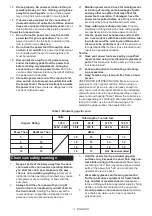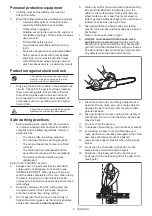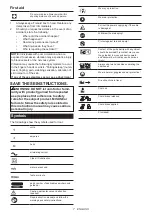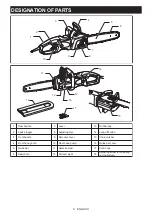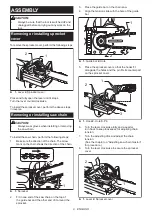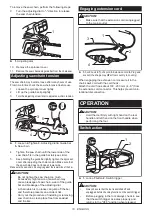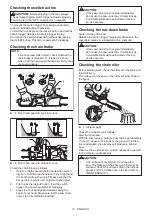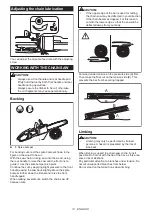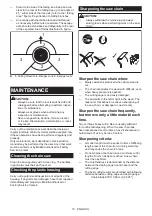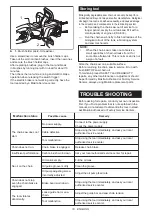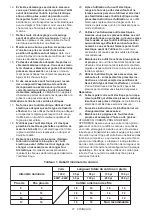
14 ENGLISH
Burrowing and parallel-to-grain cuts
CAUTION:
•
Burrowing and parallel-to-grain cuts may only
be carried out by persons with special training.
The possibility of kickback presents a risk of
injury.
Perform parallel-to-grain cuts at as shallow an angle as
possible. Carry out the cut as carefully as possible, as
the spike bumper cannot be used.
Felling
CAUTION:
•
Felling work may only be performed by trained
persons. The work is hazardous.
Observe local regulations if you wish to fell a tree.
45
o
2
1
/
2
45
o
1
►
1.
Felling area
— Before starting felling work, ensure that:
(1) Only persons involved in the felling operation
are in the vicinity;
(2) Any person involved has an unhindered path
of retreat through a range of approximately
45 ° either side of the felling axis. Consider
the additional risk of tripping over electrical
cables;
(3) The base of the trunk is free of foreign
objects, roots and ranches;
(4) No persons or objects are present over a
distance of 2 1/2 tree lengths in the direction
in which the tree will fall.
— Consider the following with respect to each tree:
•
Direction of lean;
•
Loose or dry branches;
•
Height of the tree;
•
Natural overhang;
•
Whether or not the tree is rotten.
— Consider the wind speed and direction. Do not
carry out felling work if the wind is gusting strongly.
— Trimming of root swellings: Begin with the largest
swellings. Make the vertical cut first, then the
horizontal cut.
— Cut a scarf: The scarf determines the direction in
which the tree will fall, and guides it. It is made
on the side towards which the tree is to fall. Cut
the scarf as close to the ground as possible. First
make the horizontal cut to a depth of 1/5 -1/3 of
the trunk diameter. Do not make the scarf too
large. Then make the diagonal cut.
— Cut any corrections to the scarf across its entire
width.
— Make the back cut a little higher than the base
cut of the scarf. The back cut must be exactly
horizontal. Leave approximately 1/10 of the trunk
diameter between the back cut and the scarf.
The wood fibers in the uncut trunk portion act as
a hinge. Do not cut right through the fibers under
any circumstances, as the tree will otherwise fall
unchecked. Insert wedges into the back cut in
time.
— Only plastic or aluminum wedges may be used to
keep the back cut open. The use of iron wedges is
prohibited.
Summary of Contents for UC3551A
Page 59: ...59 ...



